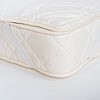Flame Retardant Mattresses – Your questions, answered.
Having a fire in the home is a nightmare scenario. In 2015 alone, there were 365,500 house fires an estimated $7 billion dollars in direct property damage. Don’t forget about the destructive emotional cost that comes from having your home and sense of security destroyed by flames.
Thankfully, the U.S. Consumer Product Safety Commission (CPSC) has flammability standards that mattresses have to meet. Flame retardant mattresses are standard, but many mattress manufacturers use dangerous methods and chemicals to meet these flammability standards.
Here at SleepLily, we get a lot of questions regarding the use of flame retardant in mattresses, so we created a list of the most important information you should know about flame retardant mattresses.
Q: What does flame retardant mean exactly?
A: Flame retardant refers to the chemicals used in products to meet flammability standards. The key word here is “retardant”, which refers to something to that delays combustion, not resists it completely. Flame retardant mattresses are not fireproof, but they may stop small fires from happening or give you time to escape in the case of dire situations.
Q: What are the CPSC flammability standards for mattresses?
A: The vast majority of fires in the bedroom are started by cigarettes, so the CPSC tests the flammability of mattresses with, you guessed it, cigarettes. That’s right, it’s somebody’s job to try and set mattresses on fire with lit cigarettes. Mattresses also need to be able to withstand the 2 foot wide, open flame of a blowtorch for 70 seconds to pass the test.
Q: Are traditional flame retardant chemicals dangerous?
A: Yes. While the government had good intentions establishing flammability standards for mattresses, they did a poor job regulating the methods used to meet these standards. Poor labeling regulations mean that manufacturers don’t often disclose the chemicals they use to make their mattresses flame retardant.
Chemicals like Vinylidene Chloride, Boric Acid, Melamine, and many others found in mattresses are known carcinogens. The CPSC claims these chemicals aren’t dangerous because they’re contained inside the mattress, but they off-gas and become airborne. Widespread consumer health issues linked to mattresses with these chemicals indicate the same.
Guess what happens when a mattress containing dangerous chemicals catches on fire? Toxic smoke is released. Remember, no mattress is truly flame-proof, and the toxic fumes released through fire can easily be more dangerous than the fire itself.
Q: What are the health risks associated with the chemicals in flame retardant mattresses?
A: There are various health risks due to traditionally used flame retardants. Studies have linked flame retardant chemicals to many serious health issues including mental and physical developmental problems, cancer, reproductive toxicity, lower IQ, and more. A quick google search brings up an alarming amount of studies and horror stories linked to these chemicals.
There have been claims that Sudden Infant Death Syndrome (SIDS) is linked to flame retardant chemicals. There’s heated debate surrounding the issue, and while the link has been neither proven nor disproven, the fragile immune system of an infant sleeping on top of a bed of known carcinogens makes us very uncomfortable.
Q: Why do manufacturers use flame retardants proven to be dangerous?
A: In short, the sad truth is that they do it to save money. For more info, check out our detailed post here.
Q: Where can I get a mattress that is guaranteed to be free of toxic chemicals?
A: Look no further! Our Non-Toxic Mattress collection is the heart of SleepLily. Each mattress is hand-crafted in California and uses only the safest, most natural ingredients – like our organic cotton, Pure Grow wool, and natural latex. At every step in the process, we go to great lengths to keep harmful chemicals out and create the safest, most comfortable beds for you and the ones you love.
If you have any more questions about flame retardant mattresses, fire! (get it) But really, comment below! Your safe sleep is our priority!




